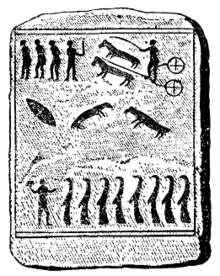Tomb of Kivik
The grave of Kivik , also royal grave (Swedish: Kiviks- or Kungagraven ) in Bredarör near Kivik , in the Swedish region of Österlen in southeastern Skåne , is the restored remains of a burial from the Nordic Bronze Age (approx. 1000 BC). The Röse was not only used as a quarry, but was also carelessly restored at first. Both in construction and in dimensions with a diameter of 75 meters, it differs from most of the northern European graves of the Bronze Age . However, stone boxes under stone mounds are a typical form of this time in Sweden and, to a lesser extent, in Denmark . The unique petroglyphs of the stone box depict people, ships, luras , symbols and a chariot with two horses.
It is located about 320 m from the coast. Near the find carvings of Simrishamn , immediately adjacent to the two large stone settings (Penning Graven - grave coins - and a 60 m long ship reduction ) on the burial site of Ängakåsen in Bredarör .
history
The grave was used as a quarry for local construction work until 1748. Two farmers discovered a 3.25 m long north-south-oriented chamber made of ten stone slabs. In the hope of finding treasure, they dug the grave - whether they found treasure is unclear.
Only later was it discovered that the stone slabs had petroglyphs on them. However, stones continued to be broken and some of the plates disappeared.
From 1931 to 1933 there was a thorough excavation, which also found the remains of a Stone Age settlement under the hill, as well as large amounts of flint debris . Only teeth, bronze fragments and bone fragments were found from the Bronze Age.
The hill contained two chambers. On the left side of the southern end of the first, stone slabs of a 1.2 m long and 0.65 m wide second chamber were found. Because of its size, it was called the Prince's Tomb . Since it was looted, there were no reliable finds, but it is believed that both graves were dug at the same time.
After the excavation, the grave was restored, but it is not known to what extent the restoration corresponds to the original condition. A comparison with contemporary graves suggests that the grave should be three times as high as the current 3.5 m. The restoration was based on 18th century etchings and guesswork. A concrete chamber was made and a short tunnel was built into the chamber near the middle.
The grave and the rock carvings in the chamber can be viewed.
See also
literature
- Joakim Goldhahn: Bredarör i Kivik. Nya analyzer and catering from mannniskoben . In: Fornvännen 100, 2005, 2, ISSN 0015-7813 , pp. 97-100, (Bredarör in Kivik. New analyzes and data on human bones).
Web links
Coordinates: 55 ° 40 ′ 57.7 " N , 14 ° 14 ′ 2.2" E




